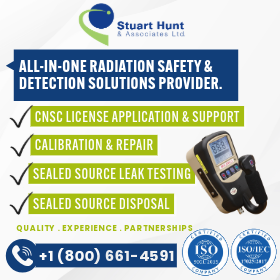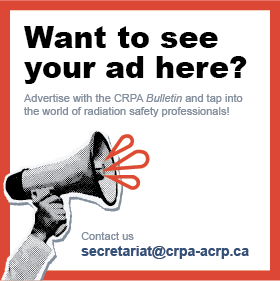Radon Testing in the Workplace

Radon is the second most common cause of lung cancer in Canada and the leading cause of lung cancer in non-smoking Canadians. It is important to be aware of high levels of radon exposure.
Last fall, the Radiation Safety Institute of Canada (RSIC) invited Jill Robertson, Ali Shoushtarian, and Jillian Woods to share their experiences with radon testing in workplaces as part of a webinar panel.
- Jill Robertson is the radiation safety manager with the Environmental Health and Safety Office at Dalhousie University.
- Ali Shoushtarian is the manager of nuclear substances safety and regional partners RSO with The Ottawa Hospital.
- Jillian Woods is the manager of real estate, environment, and sustainability with Canada Post in Winnipeg.
- Pam Warkentin is the executive director of the Canadian Association of Radon Scientists and Technologists (CARST) and the Canadian – National Radon Proficiency Program (C-NRPP) She was present to help answer questions from attendees.
RSIC thanks Jill, Ali, Jillian, Pam, and the Canadian Radiation Protection Association (CRPA) Bulletin for allowing us to share their answers to some of the questions asked in the panel interview. These answers shared here have been edited for clarity and compactness. The full webinar included information on radon, radon testing and mitigation, regulatory requirements, and answers to several other questions. The recording is available on our YouTube channel.
You can obtain a PDF of the slides, answers to the questions asked, and a webinar certificate for watching the video via our elearning platform.

What motivated you to ensure your workplace buildings were tested for radon?
Jill Robertson
What motivated me stems from my previous work as a healthcare provider and now as a radiation safety professional. I feel it’s part of my job to make people aware of radon and to test their workspaces. At the Dalhousie Environmental Health and Safety Office, a large part of our job is to educate people, and to grow and foster a positive safety culture. We believe everyone has a right to work in a safe, healthy space. For me, testing for radon is one of the ways I get to contribute to this.
Ali Shoushtarian
As we all know, radon is a leading cause of lung cancer among nonsmokers. I was motivated to ensure our workplace and buildings were safe. At the same time, I wanted to increase radon awareness at workplaces. This leads to a healthier population, which is key to having a better workplace and safer environment.
Jillian Woods
At Canada Post, we are a federally regulated workplace. So, the motivation came from having to confirm compliance with the current regulations, the action limit being 800 Bq/m3. The thought process really was, if you don’t test it, you don’t know if it’s there or not. Health and safety are top priorities at Canada Post, and we want to verify that our buildings are safe.
What efforts did you take to try to help your coworkers or staff learn about radon?
Jillian Woods
The first thing I did was become the subject matter expert. I started going to CARST conferences. I became a certified radon measurement professional and then started to educate my coworkers through information sessions. We have standing agreements with our consultants who specialize in this area. We had them do information sessions as well.
We established communications or talk tracks so that we could have program transparency. We do annual updates about how our program is moving along. We are always, when we do our test cycle, providing details about how we are deploying detectors and how we are retrieving them, not only to management, but also to local employees.
We encourage employees to learn about radon and to test their own homes. We have even reached out to our national Canadian Postmasters and Assistants Association (CPAA) union, and they agreed to put some information in their postmaster magazine, which is great. We do information messages that go out by email. We started back in 2016. So, we have been doing this for quite a few years.
Jill Robertson
I have access to a large community of people working at the university—over 6,000 staff and 2,100 students. Whenever I can, I like to take advantage of this. Often, we’re asked to give presentations across the university’s different areas. Whenever it’s applicable, my topic of choice is radon awareness.
This year, we released news articles on our SharePoint site. Everyone at Dalhousie that is looking for information, whether it is human resources or safety-related information, has to go to SharePoint. So, there is a newsletter that we put out on SharePoint. Dalhousie also has an email newsletter, so we put an article in there. Next week, I’m presenting at the university’s Joint Occupational Health and Safety Committee meeting about radon.
We have also created, through our office, a radon website through the environmental, health, and safety internal site. It has lots of information there with links to external organizations and our Nova Scotia assistance programs for testing and mitigation. We try to provide as much information as we can.
One other thing that we have done is created what we call our radon maps for Dalhousie. So, anyone can go on to these maps, see if their building was tested, and see what the actual test results were. That is something we have on our site as well.
And, of course, when we are deploying our test kits, we have the opportunity to talk to many, many people. Our offices and spaces are typically full of occupants when we are there. So, we get the chance to teach them about radon. We always tell them they should be testing their homes as well.
So, there are lots of opportunities for us to reach people at Dalhousie.
Ali Shoushtarian
I take a different angle. I wanted to get the senior management on board. So, we did a lot of practice and presentations to get them on board before we even started doing radon testing at The Ottawa Hospital.
After we had their blessing, if you want to call it that, we went full force. We created a pamphlet to inform staff on what we are doing and what the risks are from radon. Then, we put it on our SharePoint website. We started having a radon booth during the health and safety months. I think that was really beneficial because we could talk to staff and educate them to increase awareness.
We started putting articles about radon in “What’s Happening,” the internal newsletter at The Ottawa Hospital, especially during Radon Action Month in November. We wanted to increase awareness and make sure staff are doing their testing at home.
We are also on social media, using Facebook. We put some articles there every couple of months to increase radon awareness.
Lastly, we created these radon table tent cards, which had a blurb about the danger of radon, and distributed them on each cafeteria table at the hospital to increase awareness.
Did you find you needed to mitigate? If so, what was that like again?
Ali Shoushtarian
That is a very good question! No, so far, we have been lucky. I don’t know if you want to knock on wood, but, so far, all the rooms that we have tested across our campuses were below the Health Canada guidelines limit of 200 Bq/m3. However, if we do find a test reading higher than the Health Canada guide limits, I will definitely hire a professional (unfortunately, I’m not a mitigation professional) to mitigate and bring the levels below the Health Canada limit.
Jillian Woods
Absolutely! As a federally regulated workplace, we mitigate at 800 Bq/m3. We follow our legal requirements. However, we have recently taken a proactive approach. If there are higher levels, well above the Health Canada guideline of 200 Bq/m3, but still below the 800 Bq/m3, we will also mitigate within two years. We work with certified radon mitigation consultants as well as professionals and subcontractors.
Jill Robertson
Like Ali, I have been fortunate that I have not found a place that is over 200 Bq/m3. I know in the past there were a couple of spots, and we did hire external, certified mitigators to correct the situation.
What is one piece of advice you would offer to those who might wish to implement this in their workplace?
Jillian Woods
It can be a lengthy process. So, it is really just important to set expectations. From the time you have tested to the time the mitigation system goes in, it could be two years. Let employees know that this is a long-term health risk, and you have a plan to reduce the radon levels. Be clear and set appropriate expectations.
Ali Shoushtarian
I would say the major advice would be to be transparent. Stick with the facts about the risk of radon, and get senior management engaged and involved at the early stages. It might not work the first time. It didn’t work for me the first time, either. Don’t give up, and try again.
Jill Robertson
I think my advice would be to communicate. Let people know before you show up knocking on the door to go in and start putting test kits around—that tends to cause a little bit of alarm. Always let them know in advance that you will be coming. I like to send out information about radon so they have the opportunity to read about. Then they can ask me questions when I come in if they don’t understand or if they have some concerns.
I get much better cooperation from the staff when they know well in advance that I am coming and what to expect. Like, “oh, this test kit has to stay here for at least 91 days so you can’t move it.” So that would be my advice—offer good communication around what you are doing and why you are doing it, and give them the opportunity to talk to you about any questions or concerns that they have.
Pam Warkentin
Firstly, kudos to Jill, Ali, and Jillian. Thank you. You guys have been standout examples. We really want to celebrate that.
For the rest that have not taken action, one of the comments or the fears that we often hear is that people think this is going to panic their workplaces. We are not seeing panic. There have been some examples of people who overreacted because they did not have the information up front. So, we do recommend good communication. We also recommend being forward thinking. We really encourage everybody to just dive in and start to take action on it.
 Lynn MacDonald
Lynn MacDonald
Lynn is the manager of training and a liaison scientist at the Radiation Safety Institute of Canada (RSIC). Her scientific training at the University of Prince Edward Island and the University of Toronto included research projects in condensed matter physics, non-linear pattern formation, and biophysics. Her educational career includes adult and public education, as well as public school administration. At RSIC, she coordinates and teaches courses in radiation safety, manages the eLearning site, and hosts the institute’s free webinars on a variety of radiation safety topics.
Do you want to read more articles like this?
The Bulletin is published by the Canadian Radiation Protection Association (CRPA). It’s a must-read publication for radiation protection professionals in Canada. The editorial content delivers the insights, information, advice, and valuable solutions that radiation protection professionals need to stay at the forefront of their profession.
Sign up today and we’ll send you an email each time a new edition goes live. In between issues, check back often for updates and new articles.
Don’t miss an issue. Subscribe now!
Subscribe

 Lynn MacDonald
Lynn MacDonald

